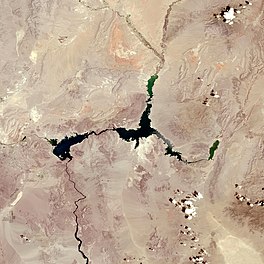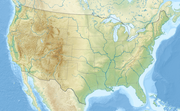
Back Мід (вадасховішча) Byelorussian Мийд (язовир) Bulgarian Llac Mead Catalan Mead (přehradní nádrž) Czech Lake Mead Danish Lake Mead German Lago Mead Spanish Meadi järv Estonian Lac Mead French אגם מיד HE
| Lake Mead | |
|---|---|
 Satellite imagery from Landsat 8 of Lake Mead in July 2022 during the 2020–23 North American drought | |
| Location | Clark County, Nevada and Mohave County, Arizona |
| Coordinates | 36°15′N 114°23′W / 36.25°N 114.39°W |
| Lake type | Reservoir |
| Primary inflows | Colorado River, Virgin River |
| Primary outflows | Colorado River |
| Basin countries | United States |
| First flooded | September 30, 1935 by the Hoover Dam |
| Max. length | 120 mi (190 km) |
| Surface area | 247 sq mi (640 km2) |
| Max. depth | 532 ft (162 m) |
| Water volume | Maximum: 26,134,000 acre⋅ft (32.236 km3) |
| Shore length1 | 759 mi (1,221 km) |
| Surface elevation | Maximum: 1,229 ft (375 m) |
| Website | Lake Mead National Recreation Area |
| 1 Shore length is not a well-defined measure. | |
Lake Mead is a reservoir formed by the Hoover Dam on the Colorado River in the Southwestern United States. It is located in the states of Nevada and Arizona, 24 mi (39 km) east of Las Vegas. It is the largest reservoir in the US in terms of water capacity. Lake Mead provides water to the states of Arizona, California, and Nevada as well as some of Mexico, providing sustenance to nearly 20 million people and large areas of farmland.[1]
At maximum capacity, Lake Mead is 112 miles (180 km) long, 532 feet (162 m) at its greatest depth, has a surface elevation of 1,229 feet (375 m) above sea level, has a surface area of 247 square miles (640 km2), and contains 28.23 million acre-feet (34.82 km3) of water.
The lake has remained below full capacity since 1983 owing to drought and increased water demand.[2][3][4] As of May 31, 2022, Lake Mead held 26.63% of full capacity at 7.517 million acre-feet (9,272,000 megaliters), having dropped in June 2021 below the reservoir's previous all-time low of 9.328 million acre-feet (11,506,000 megaliters) recorded in July 2016, and never returning to that level.[5] By December 2024, following the implementation of water conservation measures, Lake Mead's water levels had risen by 16 feet again over two years.[6]
- ^ "Drought: Lake Mead is at an Historic Low". Ecowatch. April 28, 2015. Archived from the original on September 25, 2015.
- ^ USGS Circular 1381: A Synthesis of Aquatic Science for Management of Lakes Mead and Mohave. 2012. p. 11. Archived from the original on August 14, 2013.
- ^ Bureau of Reclamation, Lower Colorado Region, Hoover Dam Web Designer. "Bureau of Reclamation: Lower Colorado Region – Hoover Dam: Lake Mead FAQs". Usbr.gov. Archived from the original on May 20, 2012. Retrieved December 13, 2014.
{{cite web}}: CS1 maint: multiple names: authors list (link) - ^ Ferrari, Ronald L. (February 2008). "2001 Lake Mead Sedimentation Survey" (PDF). U.S. Bureau of Reclamation. Archived from the original (PDF) on September 21, 2012. Retrieved February 26, 2012.
- ^ "Lake Mead Water Database". lakemead.water-data.com. Retrieved June 10, 2021.
- ^ Rode, Erin (December 10, 2024). "America's largest reservoir is filling up with water thanks to California". SFGATE. Retrieved December 12, 2024.

